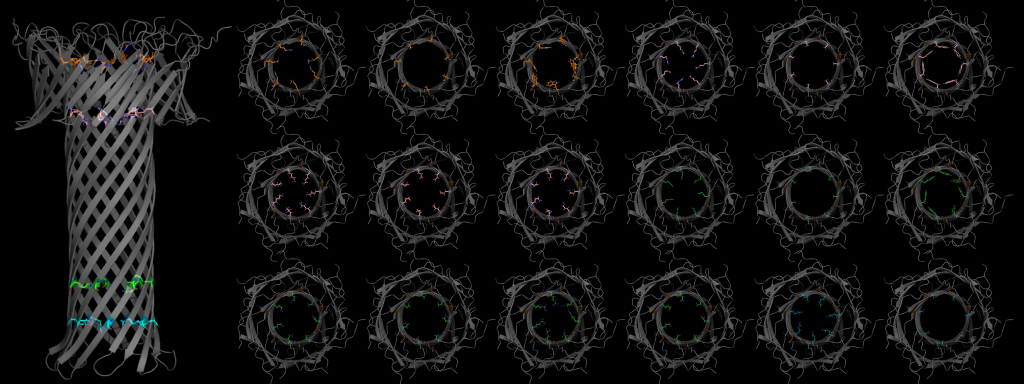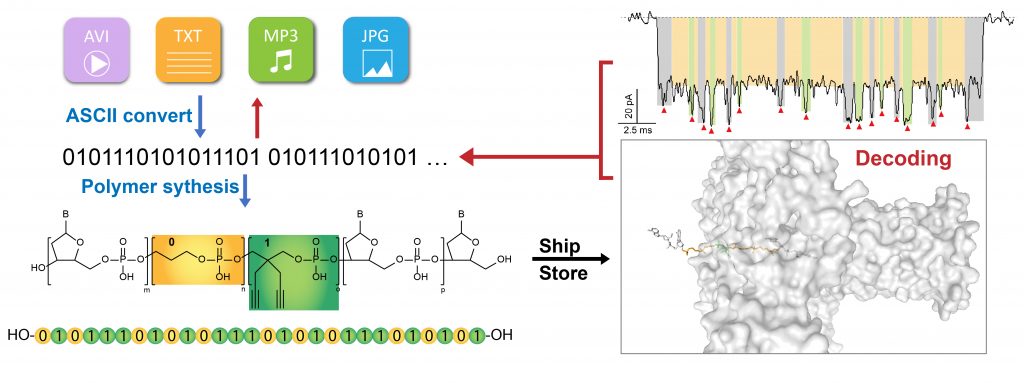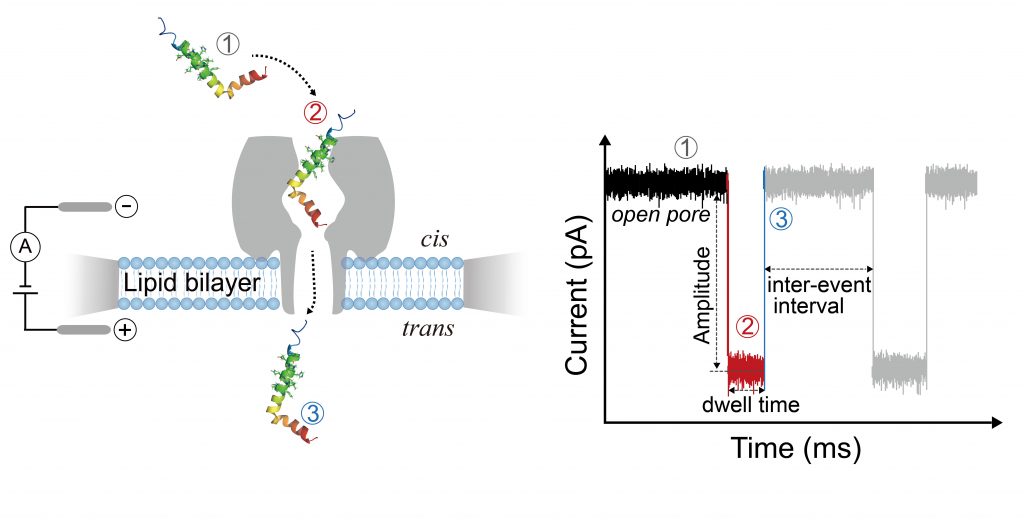Nanopore sensing is a powerful approach for detecting various organic and inorganic molecules, sequencing long strands of DNA, and sensing proteins and peptides at the single-molecule level. To achieve this, many proteins have been utilized as biological nanopore sensors. Each of these sensors is unique and plays a vital role in their specific applications in molecular sensing. As nanopore sensing technology has been widely applied in many fields, there is a need for novel biological nanopores. To meet this demand, we are seeking new candidates and then to improve or reinvent them through molecular engineering and design.

Engineered aerolysin nanopores (Credit: Chan Cao)
Research paper:
Cao, C., Cirauqui, N., Marcaida, M.J. et al. Single-molecule sensing of peptides and nucleic acids by engineered aerolysin nanopores. Nature Communications 10, 4918 (2019). https://doi.org/10.1038/s41467-019-12690-9
As digital data continuously accumulate, high density and long-term storage are necessary. Precise synthesis of sequence-defined abiotic polymers has recently opened up the possibility to tune important parameters, such as storage capacity, storage density, erasability, readability and writing speed. However, synthetic informational polymers are so far only sequenced by mass spectrometry, a technique that is currently incompatible with affordable and portable data storage devices. In comparison, nanopore technique is faster, cheaper, non-destructive, and low energy cost. More importantly, nanopores are ultrasensitive down to the single-molecule level and hold the potential of integration into portable devices. We are working towards the development of molecule-based digital data storage, aiming at decoding informational polymers using our nanopore sensing platform.
As an informational polymer (bit-0, yellow; bit-1, green) translocates through the reading site of an engineered aerolysin nanopore, two distinguishable ionic current levels are recorded.
Research paper:
Cao, C.; Krapp, L. F.; Al Ouahabi, A.; König, N. F.; Cirauqui, N.; Radenovic, A.; Lutz, J.-F.; Peraro, M. D., Aerolysin nanopores decode digital information stored in tailored macromolecular analytes. Science Advances, 6 (50), eabc2661 (2020).
A biomarker is a measurable indicator of a specific biological state, the presence or the stage of disease. Better biomarkers are urgently needed to improve diagnosis, guide molecularly targeted therapy and monitor activity and therapeutic response across a wide spectrum of disease (Rifai et al., Nat. Biotechnol., 2006, 24, 971). However, only a handful of techniques are available for biomarker discovery and validation, and the low sensitivity and selectivity of existing techniques limit their application. Single-molecule nanopore technique has the potential to revolutionize proteomics, providing high sensitivity for the detection of low-abundance proteins (Restrepo-Pérez et al., Nat. Nanotechnol., 2018, 13, 786) and high specificity in mixtures. With a large library of engineered aerolysin nanopores we have built, we are targeting to develop a nanopore-based platform for the detection of potential protein biomarkers.
Review paper:
Wu, J., Cao, C., Loch, R., Tiiman, A., & Luo, J. Single-molecule studies of amyloid proteins: From biophysical properties to diagnostic perspectives. Quarterly Reviews of Biophysics, 53, E12 (2020). doi:10.1017/S0033583520000086
Biological nanopores have been successfully applied in DNA sequencing, however, their throughput and reading length is unmatched and amplification is not required. The base-calling accuracy of nanopores has not yet reached the level of second-generation sequencing, which limits its application. Among all kinds of pore materials, including both biological and solid-state materials, aerolysin is one of the most promising one for identifying the subtle difference of detected molecules due to the geometry and electrostatic features of its channel. Several works have shown aerolysin’s exceptionally high sensitivity, dwell time and signal to noise ratio for analytes like DNA, peptides and polymers. Aerolysin also has four constriction points that can be further engineered, allowing for improvement of the base-calling accuracy in the nanopore-based sequencing approach. Meantime, the great success of nanopore sensing in DNA sequencing has inspired its application for protein sequencing, which is an exciting field to explore. Herein, we are also developing strategies for protein sequencing using our nanopore platform.